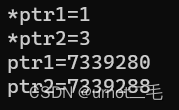1、Runloop基本认识
- 每个程序都有一个Runloop,这个Runloop简单可以理解为一个死循环,目的是为了保证程序不会退出。
- 每个程序的入口函数就会创建这个Runloop。
- Runloop中可以处理各种事件,触摸事件,点击事件,网络请求等。
- Runloop的好处可以节省CPU资源,休眠的时候就不会占用太多CPU资源。
int main(int argc, char * argv[]) {
NSString * appDelegateClassName;
@autoreleasepool {
// Setup code that might create autoreleased objects goes here.
appDelegateClassName = NSStringFromClass([AppDelegate class]);
}
return UIApplicationMain(argc, argv, nil, appDelegateClassName);
}
int main(int argc, char * argv[]) {
NSString * appDelegateClassName;
@autoreleasepool {
// Setup code that might create autoreleased objects goes here.
appDelegateClassName = NSStringFromClass([AppDelegate class]);
}
int res = 0;
do {
int message = sleep();
res = doSomething(message);
} while (res== 0);
return UIApplicationMain(argc, argv, nil, appDelegateClassName);
}
2、Runloop对象
- iOS中有2套API来访问和使用Runloop
Foundation: NSRunloop
Core Foundation: CFRunloopRef - NSRunloop是基于CFRunloopRef 的一层OC包装
- CFRunLoopRef是开源的
- 重要点:CFRunLoop是纯C语言实现的,是线程安全的,NSRunloop非线程安全
NSRunLoop *runloop = [NSRunLoop currentRunLoop];
CFRunLoopRef runloop2 = CFRunLoopGetCurrent();

可以看到,CFRunLoopRef的地址和NSRunLoop的_rl的地址指向是一样的
3、Runloop与线程
- 每条线程都有唯一的一个与之对应的Runloop对象
- Runloop保存在一个全局的Dictionary里,线程作为key,Runloop作为value
- 线程刚创建时并没有Runloop对象,Runloop会在第一次获取它时创建
- Runloop会在线程结束时销毁
- 主线程的Runloop已经自动获取(创建),子线程默认没有开启Runloop
dispatch_async(<#dispatch_queue_t _Nonnull queue#>, ^{
// 子线程默认没有Runloop,除非手动调用
[NSRunLoop currentRunLoop];
});
NSRunLoop *runloop = [NSRunLoop currentRunLoop];
NSRunLoop *runloop1 = [NSRunLoop mainRunLoop];
CFRunLoopRef runloop2 = CFRunLoopGetCurrent();
CFRunLoopRef runloop3 = CFRunLoopGetMain();
原文地址:https://blog.csdn.net/JH_Cao/article/details/122573345
本文来自互联网用户投稿,该文观点仅代表作者本人,不代表本站立场。本站仅提供信息存储空间服务,不拥有所有权,不承担相关法律责任。
如若转载,请注明出处:http://www.7code.cn/show_39472.html
如若内容造成侵权/违法违规/事实不符,请联系代码007邮箱:suwngjj01@126.com进行投诉反馈,一经查实,立即删除!
声明:本站所有文章,如无特殊说明或标注,均为本站原创发布。任何个人或组织,在未征得本站同意时,禁止复制、盗用、采集、发布本站内容到任何网站、书籍等各类媒体平台。如若本站内容侵犯了原著者的合法权益,可联系我们进行处理。






